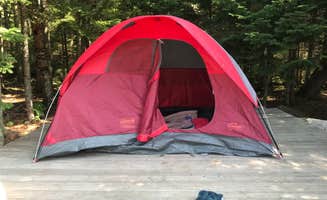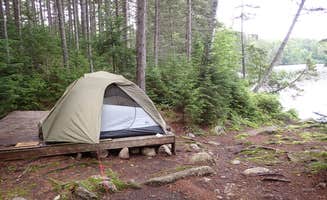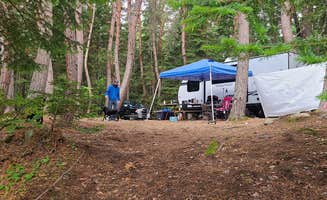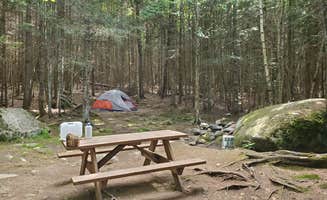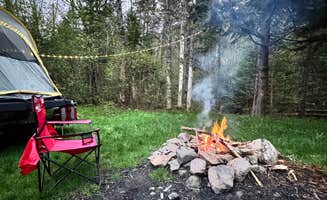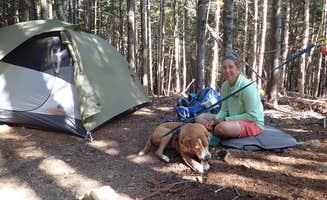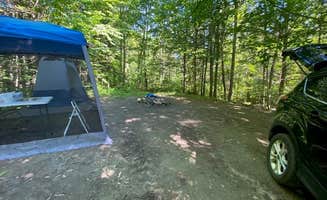Tent camping near Colebrook, New Hampshire centers around the Connecticut River Valley and White Mountain National Forest, with elevations ranging from 1,000 feet along the river to over 3,000 feet at nearby peaks. This North Country region experiences cooler temperatures than southern New Hampshire, with average summer highs in the 70s°F and nights often dropping into the 50s. The camping season typically runs from late May through mid-October, with June being especially wet.
What to do
Fly fishing opportunities: At Unknown Pond, accessible by hiking in from either Mill Brook Road or York Pond Road, campers can enjoy productive fishing. "The pond is beautiful and open to fly fishing for those with a NH fishing license. While I didn't have much luck with the fish, I was certainly surrounded by a multitude of frogs!" notes Sarah C.
Paddling adventures: The Androscoggin River near Northern Waters Base Camp offers Class II whitewater. "Situated right on the Androscoggin River this small stretch of Class II whitewater is popular with all the area rafting companies," shares Sarah C. Multi-day paddling trips are possible by connecting various river campsites.
Hiking and exploration: The region offers numerous trails connecting to backcountry sites. "You can hike in to this site from either the trailhead on Mill Brook Road (gated in winter) or from the Berlin Fish Hatchery on York Pond Road," explains a visitor to Unknown Pond. The Cohos Trail passes through the area, connecting multiple camping options with day-hiking possibilities.
What campers like
Island camping experiences: Remote Sites at Umbagog Lake State Park offers boat-access tent sites on islands. "We like being totally on an island so our dogs don't bother anyone else. The fishing is also really good here," shares Sarah C. "Most sites have newly renovated privies and tent platforms, picnic tables and fire rings."
Wildlife viewing: Many Colebrook area campsites offer excellent wildlife observation opportunities. "You can kayak with Bald Eagles soaring over your head, swim in a crystal clear lake and enjoy a near wilderness camping experience," reports Rebecca A. about the remote sites at Umbagog Lake. Moose sightings are relatively common in early morning and evening hours.
Secluded swimming spots: Lyman Falls State Park Campground features natural swimming areas. "There is also a great swimming area in a large deep eddy and the remnants of an old dam can be seen upstream," according to Sarah C. At Unknown Pond, "The pond provides drinking water so be sure to carry in a water filtration system... There is easy access to the pond and you can wade in a bit as well."
What you should know
Access limitations: Many tent sites require special transportation methods. "If you chose to drive, you will have to park at a small parking area indicated by a few large boulders and then carry your things in about 200-250 yards," notes Sarah C. about Lyman Falls State Park Campground.
Seasonal considerations: Snow can linger in the area well into spring. "Note that there can be snow on north-facing slopes into June so be prepared to post hole or carry snowshoes," warns a reviewer about Unknown Pond. Early season visits often mean encountering mud, high water, and difficult stream crossings.
Bug preparation: Insects can be intense, particularly in June and July. "Bring the bug spray mosquitoes are fierce!" warns Rebecca A. about Stephen Phillips Memorial Preserve Wilderness. Sites with better airflow tend to have fewer mosquitoes: "The bugs aren't bad if you can find a campsite with a point, the wind certainly helps."
Facility variations: Toilet facilities vary widely between sites. "There is a nice shady spot with plenty of flat space for tents. While I had positive interactions via email with someone, the individual that was in the office when I went to get my permit could have cared less," reports Sarah C. about her experience at Diamond Peaks.
Tips for camping with families
Boat-access campsites: Umbagog Lake offers family-friendly remote sites accessible by water. "The remote campsites at the northern end of Umbagog Lake are wonderful. This trip consisted of my family of five with three kids (ages 5-13), our dog, and friends. We put our boats in at the National Wildlife Refuge and paddled in on Bear Brook. The paddle was just around 2.5 miles and calm flat water. Just perfect for our kids," shares John L.
Wildlife education opportunities: Camping trips become natural science lessons. "While I didn't have much luck with the fish, I was certainly surrounded by a multitude of frogs! The amphibians provide a lovely backdrop for sleep and seem to sing all day and all night," notes Sarah C. about Unknown Pond.
Riverside tent camping: For families wanting easier access, sites along the Connecticut River provide good options. "The riverbank is a great spot to fish from and enjoy the afternoon sun. The top site is well maintained and the lower site could use a little work," reports Sarah C. about Lyman Falls State Park.
Tips from RVers
Alternative tent sites for RVers: When traveling with both RVs and tents, Cupsuptic Lake Park & Campground accommodates both. "Tented here 30 years ago and in a motor home this year. It's a nice place on the lake. Nice beach with little seating coves along the waters edge, offers a little privacy," mentions Kevin W. This provides options for groups with mixed camping preferences.






